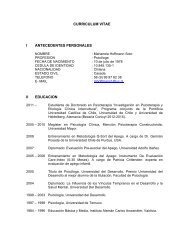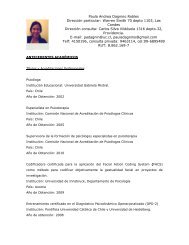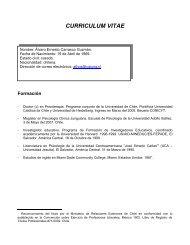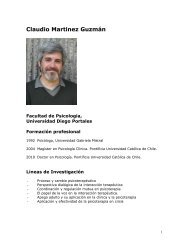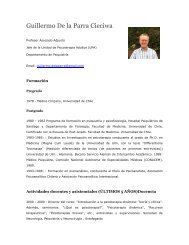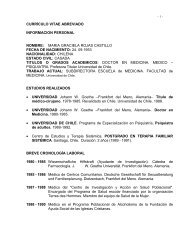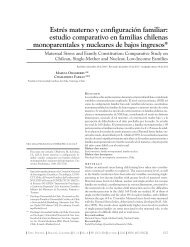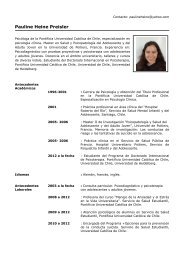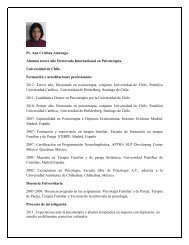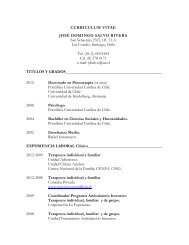3. Dagnino et al - Nucleo Milenio | Intervención Psicológica y ...
3. Dagnino et al - Nucleo Milenio | Intervención Psicológica y ...
3. Dagnino et al - Nucleo Milenio | Intervención Psicológica y ...
You also want an ePaper? Increase the reach of your titles
YUMPU automatically turns print PDFs into web optimized ePapers that Google loves.
P. <strong>Dagnino</strong> <strong>et</strong> <strong>al</strong>. 81Percentage60%50%40%30%20%10%0%Exploring Attuning ResignifyingPhase 1 Phase 2 Phase 3Figure <strong>3.</strong> Use of communicative intentions at differentstages of therapy.third therapy phase there was a more extensive use ofAttuning than in the first phase (β = -.41, OR = .67, p< .01, 95% CI [.50, .90]), but no differences were observedwhen comparing the second and third phases(β = -.27, OR = .76, p =. 71, 95% CI [.57, 1.02]).These results parti<strong>al</strong>ly support the third hypothesis.Although a decrease in Exploring was observed, therewas no evidence of an increase in Resignifying as th<strong>et</strong>herapy process progressed.Evolution of client and therapistCommunicative Intentions in changeepisode stages and therapy phasesThe fin<strong>al</strong> hypothesis stipulates that the pattern of theevolution of Communicative Intentions in differentchange episode stages and therapeutic phases will besimilar. Given the results showing the differences b<strong>et</strong>weenclients and therapists, this hypothesis must b<strong>et</strong>ested considering the speakers of the therapeuticdiscourse and the micro (change episode stages) andmacro (therapy process phases) moments of th<strong>et</strong>herapeutic process jointly.Change episode stages. In order to an<strong>al</strong>yse theeffect of the change episode stages on the probabilityof using Communicative Intentions (Exploring, Attuningand Resignifying), each of dichotomized dependentvariables was regressed on the variables actors,change episode stages and their interaction.As Table 2 shows, the relation b<strong>et</strong>ween the changeepisode stage and the probability of Exploring andResignifying depends on who the speaker is (significantinteraction terms). There were no significantinteractions b<strong>et</strong>ween actor and change episode stageswhen predicting Attuning. 2Odds ratios were estimated to account for the in-2Direct effects are not interpr<strong>et</strong>ed when interactions are present.teraction terms (Actor X Change episode stage).When the odds ratio is equ<strong>al</strong> to 1, both categorieshave the same odds. When the odds ratio is greaterthan 1, the odds for one of the categories of variables(i.e., the clients) are greater than the odds for the referencecategory (i.e., the therapist). When the oddsratio is less than 1, the reverse is true (Hosmer &Lemeshow, 2000).The results indicate that clients were <strong>3.</strong>7 timesmore likely to use Exploring than therapists in theiniti<strong>al</strong> change episode stage (OR = <strong>3.</strong>72, 95% IC[2.40, 5.75]). This pattern was less clear at the end ofthe change episode (fin<strong>al</strong> stage), where clients Exploredonly one and a h<strong>al</strong>f times more than therapists(OR = 1.69, 95% IC [1.13, 2.54]).With respect to Resignifying, the odds ratios indicat<strong>et</strong>hat clients were less likely to resignify thantherapists in the initi<strong>al</strong> (OR = .43, 95% IC [.26, .68]),and middle change episode stages (OR = .67, 95% IC[.45, .99]), <strong>al</strong>though this difference was less clear inthe fin<strong>al</strong> stage, when clients and therapists had thesame probability of Resignifying (OR = 1.17, 95% IC[.81, 1.71]).In brief, the relation b<strong>et</strong>ween the change episodestage and the probability of Exploring depends onwho the speaker is. In the initi<strong>al</strong> change episode stag<strong>et</strong>he clients explore much more frequently than therapists(3 times more frequently); in contrast, thisCommunicative Intentions asymm<strong>et</strong>ry decreases inthe fin<strong>al</strong> change episode stage. Addition<strong>al</strong>ly, som<strong>et</strong>hingsimilar occurs with Resignifying. Communicationasymm<strong>et</strong>ry, present in the initi<strong>al</strong> and middlechange episode stages and characterized by a higherResignifying rate by the therapist compared with theclient, disappears in the fin<strong>al</strong> change episode stage.Phases of the therapeutic process. In order to an<strong>al</strong>ys<strong>et</strong>he effect of the phases of the therapeutic processon the probability of using each of the CommunicativeIntentions, each of the dichotomized dependentvariables was regressed on the variables actors, therapyphase, and their interaction.As Table 3 shows, the relation b<strong>et</strong>ween phases oftherapy and the probability of Exploring, Attuningand Resignifying depends on who the speaker is (significantinteraction terms).Odds ratios indicate that clients are more likely toexplore than therapists in the first (OR = 2.99, 95%IC [2.22, 4.02]) and second phases (OR = 2.69, 95%IC [1.99, <strong>3.</strong>64]) compared to the third therapy phase.At the end of the therapy (third phase), this patternis less clear; as the use of Exploring by clients andtherapists becomes more similar (OR = 1.46, 95% IC[1.03, 2.05]).With respect to Attuning, odds ratios indicate thatclients were less likely to use Attuning than therapistsin the first therapy phase (OR = .22, 95% IC [.12,.38]) compared to the third therapy phase. In the lasttherapy phase, clients increased their tendency to Attune,thus establishing a less asymm<strong>et</strong>ric pattern in




